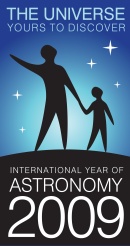
Volume XVII, Issue 42 ~ October 15 - October 21, 2009
Home \\ Correspondence \\ from the Editor \\ Submit a Letter \\ Classifieds \\ Contact Us
Dining Guide \\ Home & Garden Guide \\ Archives \\ Distribution Locations \\ Advertising
![]()

Search bayweekly.com
Search Google


Sky Watch

by J. Alex Knoll
Balance in the Solar System
Science is behind these mysteries
The waning crescent moon rises before dawn at week’s end. In the hour before dawn Friday morning, the razor-thin crescent is within 10 degrees of brilliant Venus and more subdued Saturn. Mercury shines surprisingly bright below the moon, although you may need binoculars to pick it out against the glowing horizon.

![]() While Saturn is more than 10 times the size of Venus — larger, in fact, than all the planets combined except for Jupiter — Venus is the brightest object in the heavens other than the sun and moon. Why? Remember that planets, even gaseous giants like Saturn and Jupiter, don’t emit their own light. Instead we are seeing sunlight reflected from their surfaces and back to us here on Earth. That light has to travel 10 times farther just to reach Saturn as opposed to Venus, and it then has to travel back 10 times farther to reach our eyes.
While Saturn is more than 10 times the size of Venus — larger, in fact, than all the planets combined except for Jupiter — Venus is the brightest object in the heavens other than the sun and moon. Why? Remember that planets, even gaseous giants like Saturn and Jupiter, don’t emit their own light. Instead we are seeing sunlight reflected from their surfaces and back to us here on Earth. That light has to travel 10 times farther just to reach Saturn as opposed to Venus, and it then has to travel back 10 times farther to reach our eyes.
It would be a different story if Saturn were in place of Venus, in which case the ringed planet would appear like another moon in our sky. However, it isn’t mere coincidence that the inner planets are small and solid while the gaseous giants dwell in the outskirts of the solar system. It’s all a matter of balance. Were these giants closer to the sun, our solar system’s real monster, their own mass would work against them in a gravitational tug of war, and they would be torn asunder.
Illustration: © Copyright 1925 M.C. Escher/Cordon Art-Baarn-Holland; Graphics: © Copyright 2009 Pacific Publishers. Reprinted by permission from the Tidelog graphic almanac. Bound copies of the annual Tidelog for Chesapeake Bay are $14.95 ppd. from Pacific Publishers, Box 480, Bolinas, CA 94924. Phone 415-868-2909. Weather affects tides. This information is believed to be reliable but no guarantee of accuracy is made by Bay Weekly or Pacific Publishers. The actual layout of Tidelog differs from that used in Bay Weekly. Tidelog graphics are repositioned to reflect Bay Weekly’s distribution cycle.Tides are based on National Oceanic and Atmospheric Administration and are positioned to coincide with high and low tides of Tidelog.
© COPYRIGHT 2009 by New Bay Enterprises, Inc. All rights reserved.
